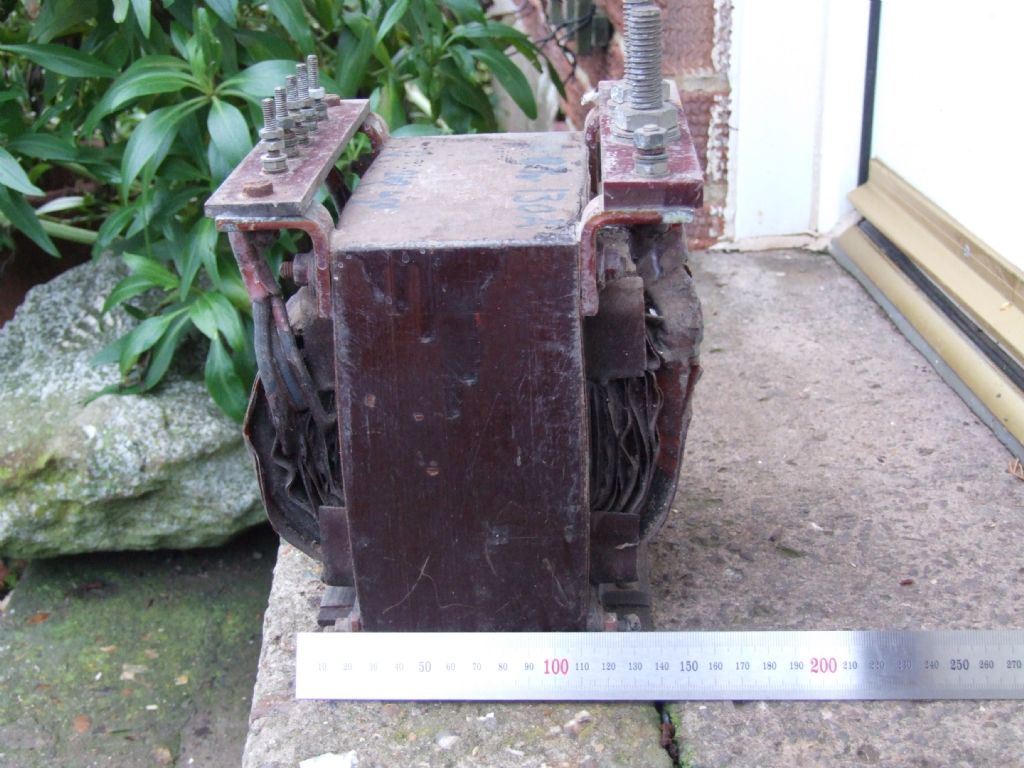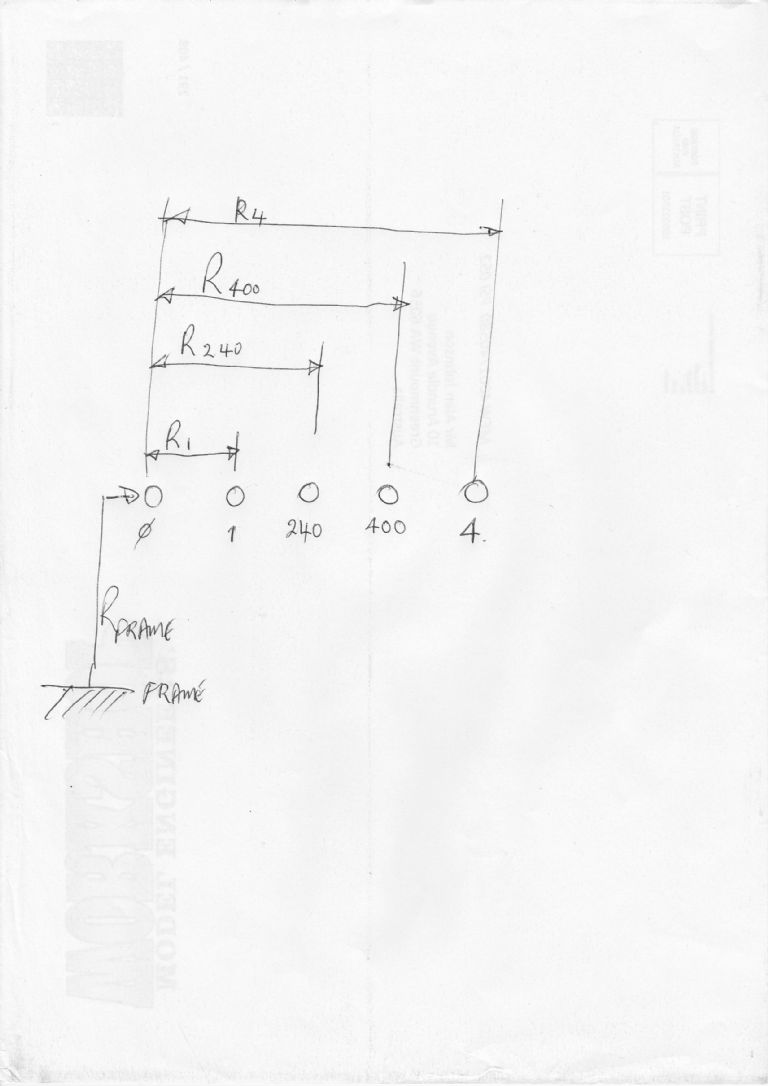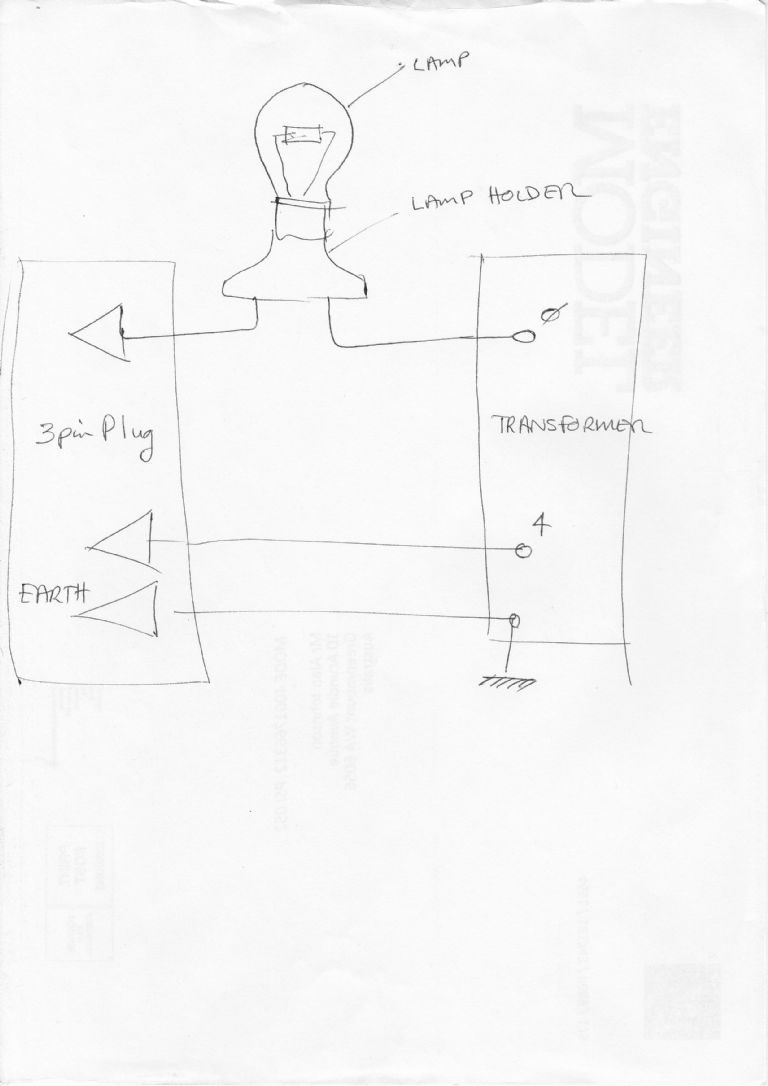IDEAS PLEASE ?
0.83V 130A
| noel shelley | 17/01/2021 12:42:48 |
| 2308 forum posts 33 photos | Gentlemen, For some time a large transormer has been waiting to be used for something ! The primary winding is marked 0-240-400-? this is unreadable and the secondary is 0.83V at 130A. There are numbers on the top,20-60,and 4600-16.The identification markings are in a white ink hand written It is very heavy and seems very well made, the sec connections are a pair of 1/2" studs ! A) Who made it ? B any ideas as to what it's original purpose was ? C) what purpose can I best put it to ? Noel One thought is that the 4600- 16 is the turn ratio. Edited By noel shelley on 17/01/2021 13:12:34 |
| Ady1 | 17/01/2021 12:45:42 |
6137 forum posts 893 photos | A few pictures will probably get you some decent responses |
| John Haine | 17/01/2021 12:58:35 |
| 5563 forum posts 322 photos | A, no idea. B resistance or spot welder. C doorstop. Or one of those! |
| Former Member | 17/01/2021 13:12:50 |
| 1085 forum posts | [This posting has been removed] |
| Jeff Dayman | 17/01/2021 13:28:33 |
| 2356 forum posts 47 photos | With the high amps and low volts at the secondary I'd guess it was for welding purposes, but apart from that no idea. Have not come across one with numbers just like that. Pics might help get responses. |
| Robert Atkinson 2 | 17/01/2021 13:29:53 |
1891 forum posts 37 photos | The output ratings give a power of about 100VA / 100W which is not that big for a transformer. Robert G8RPI. |
| noel shelley | 17/01/2021 16:56:33 |
| 2308 forum posts 33 photos | |
| Howard Lewis | 17/01/2021 19:16:13 |
| 7227 forum posts 21 photos | If the low voltage output is AC you could use a voltage doubler rectifier circuit to produce half cycle DC, although 1.86 volts still isn't a lot Unless you want to recharge a LOT of NiCads! Howard |
| not done it yet | 17/01/2021 19:27:36 |
| 7517 forum posts 20 photos | My guess is that it would have been used for inducing a strong magnetic field around a conductor - for something or other... |
| John Olsen | 17/01/2021 20:33:40 |
| 1294 forum posts 108 photos 1 articles | It doesn't seem like enough for a spot welder, where a single turn made from layers of copper sheet would be more usual, and a current more like 1000 Amps. A filament transformer for some sort of large vacuum tube might be a possibility. John |
| Gordon A | 17/01/2021 21:30:26 |
| 157 forum posts 4 photos | Resistance soldering unit for etched brass loco kits etc or a demagnetiser perhaps? Gordon. |
| Oven Man | 17/01/2021 21:36:10 |
204 forum posts 37 photos | Could have been part of a strip hardening furnace where the nichrome or other heat resisting steel liner is used as the actual heating element. This was a technique used 50 or 60 years ago but I haven't seen anything recently. Transformer looks like it is at least 50 years old. Peter |
| Robert Atkinson 2 | 17/01/2021 21:59:07 |
1891 forum posts 37 photos | Still think a small resistance welder. The sort of thing used for thermocouples or electrical connection e.g nichrome heting element to copper terminal. The size implies a conservative rating for the core so a high duty cycle application. The 240 / 400V primary imples industral use. I did wonder about a filament transformer but most valves are fussy about current and 0.83V at 130A is 0.063 ohms total circuit resistance so very little tolerance for connection resistance etc. I'd expect to see a few primary voltage fine adjustment taps if it was a filament transformer.
|
| noel shelley | 17/01/2021 22:26:07 |
| 2308 forum posts 33 photos | Spot or resistance welding was my first thought. The 240v & 400v tappings are clear to read but there are 2 other tappings, that could be 110v or 200v and the other 415v. It is 4 times the size of a microwave transformer running at 900w, the primary posts are 2Ba, if it's rating is only 100VA it is all very over kill. Something this big drawing .5A at 240V and 2Ba posts ? Kicking off a big mercury rectifier ? 240v /.83v =289.1 4600/16 =287.5 it may be a coincidence but 4600-16 may well be the turn ratio and would tally with the 240v to .83v Keep the ideas coming - please. Noel |
| martin haysom | 17/01/2021 23:48:52 |
165 forum posts | how about magnetic partial N D T |
| Alan Johnson 7 | 18/01/2021 02:46:30 |
| 127 forum posts 19 photos | With your multimeter measure the winding resistances and draw a diagram with the connection points and the resistance between them, and the iron core, then publish it here. If you have one, an insulation tester set at 400 volts between the 240/400 side and the iron core. I would suspect the 240 / 400 etc. side terminals are connected to each other, and not the 1/2" stud side and DEFINITELY NOT THE iron core! |
| Alan Johnson 7 | 18/01/2021 08:25:12 |
| 127 forum posts 19 photos | If you test the transformer windings as per this test it would help. |
| Robert Atkinson 2 | 18/01/2021 12:27:21 |
1891 forum posts 37 photos | I might also have been a induction heater for bearing races Robert G8RPI. |
| noel shelley | 18/01/2021 16:11:48 |
| 2308 forum posts 33 photos | Right ! Leakage to ground better than 100meg. Resistance, 0 to tapping 1 - 0.17, 0 to2(240) 0.24, 0 to 3(400) 0.78 and 0 to4 1.18 all values in Ohms. The resistance on the secondary is so low as to be difficult to measure, less than 0.1 any help ? Noel. |
| Alan Johnson 7 | 19/01/2021 02:46:56 |
| 127 forum posts 19 photos | 1st. Observation: the insulation resistance appears good, all be it at a very low test voltage from the multimeter. 2nd. Observation: as the ratio of resistance between windings is not the same, I suspect smaller diameter wire was used as the voltages get higher. This is a common practice in transformer manufacturing when costs count. As an example, the 240V winding has a resistance of 0.24R (a nice convenient number), so I would expect (if the wire was the same size) for the 400V winding to have a resistance of about 0.4R, but it does not. Now to apply some voltage to it! You will need an incandescent lamp. Old fashioned 100W lamps are good, but a modern halogen lamp will work. This is connected in series with the supply to the transformer. The purpose of the lamp is to limit the current flow in the transformer. If it had shorted turns current flow would be large, so the lamp limits this. Connect initially to terminals 0 and 4, and connect the supply earth wire to the frame of the transformer. You are now dealing with MAINS VOLTAGE THAT CAN KILL YOU. Don’t proceed if you are not confident with what you are doing! Wear safety glasses and gloves. Energise and wait for smoke, or a burning smell. No smoke or smell the transformer is probably OK. If there is an earth leakage, your household supply earth leakage circuit breaker will trip. If it doesn’t trip you can proceed. If it does, you are the owner of a piece of scrap metal! Measure some voltages – same as you did with the resistance tests, and report back. Remember to use the AC voltage setting on the multimeter, and remember these are MAINS VOLTAGES, SO DON’T TOUCH! |
Please login to post a reply.
Want the latest issue of Model Engineer or Model Engineers' Workshop? Use our magazine locator links to find your nearest stockist!
Sign up to our newsletter and get a free digital issue.
You can unsubscribe at anytime. View our privacy policy at www.mortons.co.uk/privacy
- *Oct 2023: FORUM MIGRATION TIMELINE*
05/10/2023 07:57:11 - Making ER11 collet chuck
05/10/2023 07:56:24 - What did you do today? 2023
05/10/2023 07:25:01 - Orrery
05/10/2023 06:00:41 - Wera hand-tools
05/10/2023 05:47:07 - New member
05/10/2023 04:40:11 - Problems with external pot on at1 vfd
05/10/2023 00:06:32 - Drain plug
04/10/2023 23:36:17 - digi phase converter for 10 machines.....
04/10/2023 23:13:48 - Winter Storage Of Locomotives
04/10/2023 21:02:11 - More Latest Posts...
- View All Topics
- Reeves** - Rebuilt Royal Scot by Martin Evans
by John Broughton
£300.00 - BRITANNIA 5" GAUGE James Perrier
by Jon Seabright 1
£2,500.00 - Drill Grinder - for restoration
by Nigel Graham 2
£0.00 - WARCO WM18 MILLING MACHINE
by Alex Chudley
£1,200.00 - MYFORD SUPER 7 LATHE
by Alex Chudley
£2,000.00 - More "For Sale" Ads...
- D1-3 backplate
by Michael Horley
Price Not Specified - fixed steady for a Colchester bantam mark1 800
by George Jervis
Price Not Specified - lbsc pansy
by JACK SIDEBOTHAM
Price Not Specified - Pratt Burnerd multifit chuck key.
by Tim Riome
Price Not Specified - BANDSAW BLADE WELDER
by HUGH
Price Not Specified - More "Wanted" Ads...
Do you want to contact the Model Engineer and Model Engineers' Workshop team?
You can contact us by phone, mail or email about the magazines including becoming a contributor, submitting reader's letters or making queries about articles. You can also get in touch about this website, advertising or other general issues.
Click THIS LINK for full contact details.
For subscription issues please see THIS LINK.
Model Engineer Magazine
- Percival Marshall
- M.E. History
- LittleLEC
- M.E. Clock
ME Workshop
- An Adcock
- & Shipley
- Horizontal
- Mill
Subscribe Now
- Great savings
- Delivered to your door
Pre-order your copy!
- Delivered to your doorstep!
- Free UK delivery!














 Register
Register Log-in
Log-in


